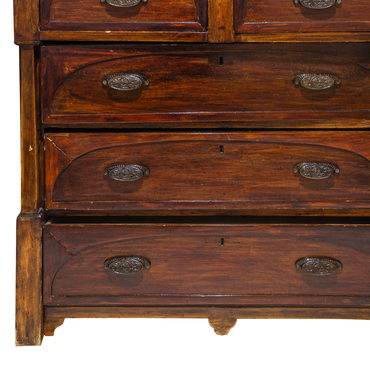The collection of the museum contains a bed of the poet Majit Gafuri. The bed frame is made of metal. The upper part of the headboard is decorated with embossed plant ornaments and decorative balls. Such metal beds were popular in Russia due to the problem with bed bugs that reproduced in wooden furniture and did not let people rest. These insects could not survive only in this metal bed frame.
Since ancient times, the bed was an indispensable item in any home. Primitive people slept in groups of several people on the floor lined with animal skins, grass and twigs. It helped them to keep warm. The ancient Egyptians were among the first to use rectangular wooden frames that had a net of straps and ropes over them to make beds. This way, they were able to raise it above the ground and create the prototype of the modern bed. Besides, scientists found the first furniture resembling beds made by the ancient Sumerians — they arranged a sleeping place on a special elevation about five thousand years ago.
The ancient Romans were the first to make wooden beds with a headboard. As a rule, they were decorated with bronze overlays and carvings. Such beds were called ‘lectus’. Moreover, in ancient Greece — ‘crabbathione’. Scientists have an assumption that the word ‘bed’ originated from this word.
Over time, the beds became more and more complex. In the Middle Ages they became luxurious and refined — often looking like a real work of art made of precious wood and precious stones. Only the nobility could afford such items of furniture. In the homes of ordinary people beds appeared later — in the 14th–16th centuries. As a rule, all family members slept on the same bed.
In Russia, beds became popular in the early 17th century thanks to Peter I, who instilled the habit of sleeping in beds in the local aristocracy. The peasants continued to sleep on stoves and wooden decks until the 19th century. Metal beds, like the one in the museum’s collection, were popular until the middle of the 20th century, when they were replaced by a folding sofa.
Since ancient times, the bed was an indispensable item in any home. Primitive people slept in groups of several people on the floor lined with animal skins, grass and twigs. It helped them to keep warm. The ancient Egyptians were among the first to use rectangular wooden frames that had a net of straps and ropes over them to make beds. This way, they were able to raise it above the ground and create the prototype of the modern bed. Besides, scientists found the first furniture resembling beds made by the ancient Sumerians — they arranged a sleeping place on a special elevation about five thousand years ago.
The ancient Romans were the first to make wooden beds with a headboard. As a rule, they were decorated with bronze overlays and carvings. Such beds were called ‘lectus’. Moreover, in ancient Greece — ‘crabbathione’. Scientists have an assumption that the word ‘bed’ originated from this word.
Over time, the beds became more and more complex. In the Middle Ages they became luxurious and refined — often looking like a real work of art made of precious wood and precious stones. Only the nobility could afford such items of furniture. In the homes of ordinary people beds appeared later — in the 14th–16th centuries. As a rule, all family members slept on the same bed.
In Russia, beds became popular in the early 17th century thanks to Peter I, who instilled the habit of sleeping in beds in the local aristocracy. The peasants continued to sleep on stoves and wooden decks until the 19th century. Metal beds, like the one in the museum’s collection, were popular until the middle of the 20th century, when they were replaced by a folding sofa.



